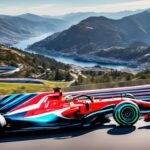Formula 1 and Rally racing are two of the most exciting forms of motorsport, yet they are vastly different. From the type of cars used to the nature of the tracks, each sport has unique characteristics that make it thrilling in its own right. In this post, we’ll explore the key differences between Formula 1 and Rally racing, highlighting their individual appeal.

The Cars: High-Tech vs. All-Terrain
The cars in Formula 1 and Rally racing are built for different purposes. Formula 1 cars are finely tuned machines designed for maximum speed and precision on smooth, closed circuit tracks. These open-wheel cars are lightweight, highly aerodynamic, and packed with cutting-edge technology. Their engines are powerful, reaching speeds of over 200 mph, and they are built to maintain high-speed stability during tight turns.
On the other hand, Rally cars are more rugged and versatile. These vehicles are designed to handle a variety of terrains, from dirt roads to snow-covered paths. They are heavier than Formula 1 cars, with reinforced bodies and suspension systems capable of absorbing the shocks from rough terrain. Rally cars are equipped with powerful engines too, but they prioritize durability and adaptability over sheer speed.
The Tracks: Controlled Circuits vs. Variable Terrain
One of the most obvious differences between Formula 1 and Rally racing is the type of track each race takes place on. Formula 1 races occur on closed, smooth circuits, which are designed to challenge drivers with high-speed straights, sharp corners, and fast chicanes. These circuits are typically between 3 to 7 kilometers in length and are located in major cities around the world.
Rally races, however, take place on public roads or off-road tracks, often in rural or remote locations. The terrain can vary drastically, including dirt, gravel, snow, and tarmac. Drivers must navigate unpredictable conditions, such as changing weather, tight corners, and obstacles like trees or rocks. Rally events can span hundreds of kilometers and typically take place over several days, with different stages occurring in various locations.
The Format: Speed and Strategy vs. Endurance and Navigation
Formula 1 races are time-based events, with the winner being the driver who completes the most laps in the shortest time. Races usually last around 1.5 to 2 hours, and strategy plays a significant role. Teams plan pit stops, tire changes, and fuel strategies to gain an advantage. The race is intense, but the focus is primarily on speed, precision, and maintaining optimal car performance for the entire race.
Rally racing, however, is more about endurance and navigation. Rally drivers compete across multiple stages, and each stage can vary in length and difficulty. Drivers rely heavily on pace notes and co-drivers to guide them through the course. The winner is determined by the overall fastest time across all stages, not just one specific race. Rally events can last for days, and the driver’s ability to manage fatigue and remain focused is crucial.
Conclusion
While both Formula 1 and Rally racing offer incredible excitement, they are fundamentally different in terms of car design, race formats, and the skills required. Formula 1 is all about speed, precision, and technology on controlled circuits, while Rally racing tests endurance, navigation, and adaptability on unpredictable terrain. Each has its own appeal and attracts a dedicated fanbase, making both sports essential to the world of motorsports.







